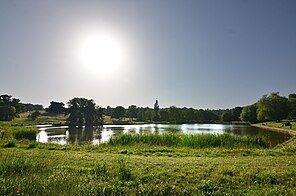| Hampstead Heath Ponds | |
|---|---|
 Hampstead Heath's Model Boating Pond
(Highgate Pond no. 3). | |
| Location | London, England |
| Coordinates | 51°33′51″N 0°9′24″W / 51.56417°N 0.15667°W |
| Type | Artificial lake/Reservoir, created 1777 |
| Primary inflows | River Fleet |
| Primary outflows | Storm Relief Sewer |
| Basin countries | England |
| Surface area | 17.3 ha (43 acres) |
| Max. depth | Varies by pond |
| Water volume | Varies by pond |
| Islands | 2 (within the 11 main ponds) |
Hampstead Heath Ponds are a series of some thirty bodies of water on or adjacent to Hampstead Heath, a vast open area of woodland and grassland in north London.
The main ponds were originally dug in the 17th and 18th centuries as reservoirs to meet London's growing water demand. These are divided into two groups: the three Hampstead Ponds (West Heath Side) and the eight Highgate Ponds (East Heath Side). Both sets of ponds are officially numbered incrementally from South to North, the southernmost pond being Hampstead no. 1 pond and the northernmost being Highgate no. 8 (Kenwood House's Wood Pond).
The majority of the ponds on Hampstead Heath are fed by the headwater springs of the River Fleet. Three of the main ponds are now large freshwater bathing/swimming ponds: two designated single sex (Highgate no. 2 male and Highgate no. 5 female); and one for mixed bathing (Hampstead no. 3). The bathing ponds are not the only special-use ponds, however: Highgate no. 3 pond is the Model Boating Pond and it, along with a few other ponds, are open to anglers. A number of the other ponds are set aside as wildlife reserves or are purely ornamental (such as the more minor Viaduct Pond). The City of London Corporation tried to close the bathing ponds in 2004, but a challenge at the High Court by swimmers overcame this, though charges for swimming were introduced.
